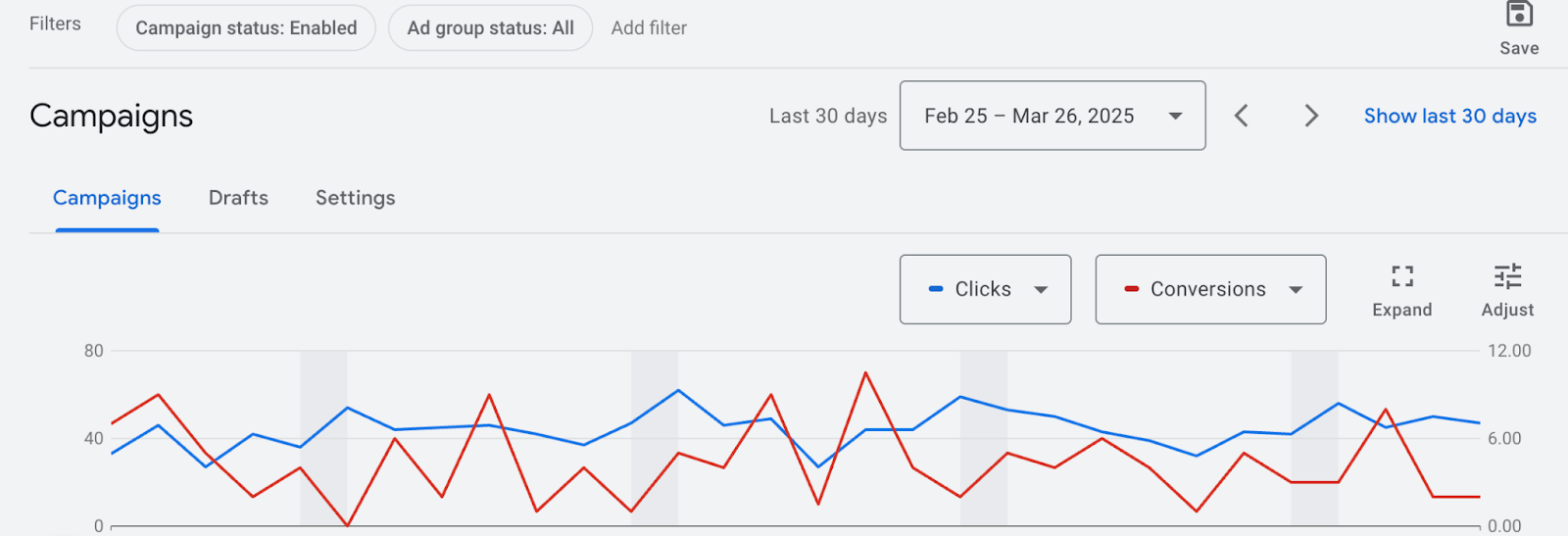One of the most common questions we hear surrounding pay-per-click (PPC) advertising is “when should I adjust the budget of my campaign to increase conversion volume?” This question is part of a larger conversation about matching your budget to your goals, which begins with budget forecasting.
PPC budget forecasting is the process of researching the expected costs of a campaign prior to launching it, whereas budget adjustments are implemented on live campaigns and informed by first-party data.
Without much experience in PPC marketing, it may seem obvious to increase your budget as soon as you see good results or reduce spending when you notice days of inactivity.
Although these are reasonable assumptions, reactive decision-making is often counterproductive for long-term business goals.
Put simply, basic cost is not the only factor to consider when adjusting your PPC budget. Marketing goals, expected cost per acquisition, and historical campaign performance all play pivotal roles in how successful your budget change will be.
With so many variables to consider and an ocean of groundless advice on the web, it’s time to clarify a few things that we’ve learned throughout the years.
When PPC budget forecasting for your search campaign, ask yourself these 5 questions to guide your planning:
1. Is my campaign producing stable & consistent results?
One of the first things to consider as you begin PPC budget forecasting for a live campaign is how stable and consistent the campaign currently is.
Stability often refers to the relative volume of conversions produced, and consistency generally refers to the quality of leads that can be expected from conversions. We want a stable baseline of conversions being collected, and we need to be able to reasonably assume that a certain percentage of our leads are qualified.
Search campaigns operate on an algorithmic system that considers numerous factors to assess user relevance and intent when participating in ad auctions. Because we’re basically defining goals for word-chasing robots, we have to make strategic changes that won’t disrupt the complex learning patterns of these AI-driven campaigns.
To assess stability, we look for a predictable pattern of impressions, clicks, and conversions, which indicates a healthy campaign with an active target audience and sustainable search volumes.
A stable campaign will have metric highs and lows that are close to the performance averages, while a learning campaign that has not yet found stability will have an abundance of volatile peaks and valleys in activity and engagement.
To assess consistency, we communicate regularly with the team responsible for contacting leads to learn more about offline lead quality.
Data provides the quantitative information we need to assess campaign performance, while communication provides much of the qualitative information we need to assess conversion value.
A stable campaign:

A campaign in the learning & refining phase:

2. Is my keyword targeting focused and reliable?
Keyword targeting is an important attribute of your search campaign that must be revisited regularly. We use keywords to show up for specific searches, and we can adjust a campaign’s degree of variance by using keyword match types.
Keyword match types include: broad match, “phrase match”, and [exact match], which function as their names imply.
Broad Match
Broad match keywords are fantastic for discovering new audiences and increasing conversion volumes, but lead quality must be assessed regularly, as these keywords can serve ads with very little restriction.
For example, the broad match keyphrase “tennis shoes” can also serve ads for the query “free tennis shoes,” even though most businesses would not want to serve an ad to someone looking for free products or services.
Phrase Match
Phrase match keywords, demarcated by the surrounding quotation marks (“,”), are less flexible than broad match keywords, but they retain the ability to explore related keyword clusters to grow your audience.
Phrase match keywords are great for experimenting with your target audience while ensuring the AI has restraints regarding the expenditure of your budget.
Exact Match
Exact match keywords, demarcated by the surrounding brackets ([,]), are the most focused type of keyword. Generally, these produce fewer conversions but the conversions are more valuable.
These keywords are often a bit more costly, but the return on investment usually makes up the difference. Exact match keywords tell us that the user is searching for our specific product or service, so it’s usually worth the additional cost.
3. Do I trust the conversions I’m currently receiving through my campaign?
Sometimes, contextualizing data points is more important than improving performance metrics. As a PPC advertiser, we have all the necessary metrics to determine if a conversion was acquired, how much it cost to acquire that conversion, the rate at which we’re converting users, and so on.
But this is only a piece of the pie.
We also need to know if the conversion attributed to the keyphrase we targeted ended up providing value to our business. It’s important to ensure that when conversions are recorded in our PPC platform, we can trust that they have value.
An example of this issue relates to unqualified leads converting for body sculpting keywords. The broad match keyphrase “body sculpting” is capable of serving ads to users who search phrases like “paid clinical weight loss trial near me.”
Once a campaign learns that it can easily get this paid clinical trial audience to “convert” for body sculpting keywords, it will have a hay day collecting as many as it can. However, when the client reaches out to these leads, they will inevitably learn that these leads have no intention of spending money.
These conversions might look impressive in the PPC platform, but they cannot be trusted to provide value to the business.
When we ask if you trust the leads your campaign is producing, what we’re really asking is if the conversions you acquire from PPC consistently translate into measurable profit.
4. How much search impression share do I already own?
Search impression share calculates the total percentage of searches related to your topic(s) that you’re currently showing up for. This is a simple factor that many people overlook when they first begin PPC budget forecasting for an active campaign.
Put simply, it may not be cost effective to increase your budget if you already own a vast portion of the search impression share available around your target keywords.
Generally, it costs much more to secure the last 10% of impression share than it does to secure the first 90%.
If your campaign is sitting around 20% of the impression share and it’s not a highly competitive phrase or market, then increasing your budget may lead to more impressions, clicks, and conversions.
However, if you already own 60% of the impression share around your keywords, you may find that increasing your share of impressions is much more costly than your historical data led you to expect.
In short, determine if your budget is the limiting factor for your reach, or if you should consider adjusting geographic targets or keyword match types to boost volume instead. It may also be valuable to consider supplementary marketing strategies if you have already saturated your target market with PPC ads.
5. Can my current offline protocols scale with my campaign?
Regular offline protocol assessment is an essential part of effective marketing of any kind. You would be surprised how many conversations circle back to the issue of rate limiters, regardless of the marketing medium.
A rate limiter refers to the current bottleneck of your profit funnel. Because we work heavily with PPC for medical practices at Lifted Logic, a common rate limiter that we see during our PPC marketing process is lead follow-up practices.
Although lead follow-up has nothing to do with the performance of our ads themselves, it does not make sense to scale a PPC budget if we’re experiencing attrition in our lead funnel.
Having structured protocols in place for lead follow-up & nurturing, along with a strategy for how your team internally markets your services or products, is essential to turning ad spend into measurable profit.
Always ensure you are maximizing the efficiency of your current spend both on- and offline before you attempt to scale.
As you assess your internal protocols, it may be valuable to benchmark your marketing ROI as well to ensure your return is greater than your expenses. After all, it’s cheaper to generate additional value through iterative process improvements than it is to expand marketing reach.
Take the next step in forecasting your PPC budget
IF: 1) your campaign is producing consistent results, 2) its keyword targeting is reliable, 3) you trust the conversions it produces, 4) you don’t own the majority of search impression share already, and 5) your current offline protocols are prepared to scale with increased volume, it may be time to consider a larger budget!
The combination of these factors means that your campaign not only has an accurate understanding of an audience that provides value to your business, but also has the potential to generate more conversions with a larger budget.
Now that you’ve asked yourself the most important questions to guide PPC budget forecasting, you can adjust your budget with confidence, knowing that it’s unlikely to disrupt the campaign’s behavior.
Please note that these adjustments will typically produce better results if implemented incrementally—rather than doubling your budget in one adjustment, consider increasing your budget by 20% every 2 weeks until you have reached your goal, assessing the impact of your changes as you go.

Can you tell when we increased the budget? 🚀💰





